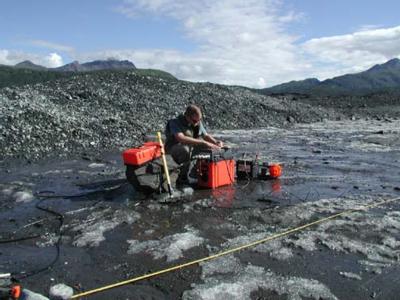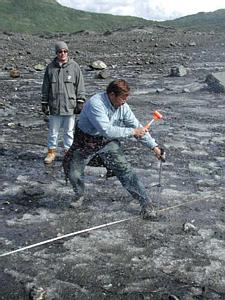29 July, 2000
July 29, 2000
Matanuska Glacier, Alaska
Today the REU group went to Anchorage to drop off Greg Baker and to
restock on some groceries. Greg has a very early morning flight tomorrow
which necessitated this trip. I decided to stay behind and analyze all
the samples that were collected the night of the 27th and morning of the
28th. We were hoping to determine if the M-4 vent had somehow gotten
shut off from the moulin or if it was possibly a reflection of flow
differences between morning and evening. In both the evening and morning
samples there was no trace of dye. Either it has iced shut or the flow
in both the evening and morning is too low right now to spill over into
the right conduit. Hopefully we can get a series of warm sunny days to
pick up the flow so that we can address that question more thoroughly.
We also wanted to confirm that M-1 and Mega Vent were still connected to
the moulin. Unfortunately we got no evening samples from M-1 due to the
battery problem. However, we got great results out of both M-1 and Mega
Vent morning samples in spite of missing the first five samples at both
locations. It does appear that connections between Mega Vent and M-1
exist at the current flow rates. We will continue to monitor all three
vents in future tests.
I really enjoyed Greg Bakerís company while he was here. I mentioned
July 19 that he was a geophysicist from SUNY-Buffalo who would be doing
some seismic studies on the glacier and the surrounding area. Being a
physics teacher I was very interested in what he was doing and the
physics behind it all. He was always more than willing to talk and
answer any questions that I had and for that I am most grateful.
Surprisingly I found that nearly everything he does could be addressed
in my classes and Iím looking forward to incorporating his work into my
curriculum.
What he was doing here was called Active Source P-wave Seismology. P
waves are longitudinal waves that transmit energy through materials. A
longitudinal wave is one in which the vibration or disturbance is back
and forth along the line of travel. Sound is a good example of a
longitudinal wave and in fact he was using sound waves in the ice. By
using a sledge hammer or a gun-like device a disturbance or vibration is
sent through the ice that travels out in all directions from the strike
just like sound would from a speaker. As the wave passes down through
the ice it is reflected by boundaries that exist between different
materials, such as that between ice and rock. The reflected wave returns
to the surface where it can be picked up with sensors called geophones.
A series of these geophones was laid out in a straight line across the
ice. At every three meters of distance a strike of the hammer would
produce signals that were processed by an instrument which basically
recorded the size of the wave and the time it arrived at the geophone.
The geophones pick up the direct waves that travel straight across the
ice from the strike in addition to the reflected waves. They also pick
up direct waves traveling through the air and also waves that are
refracted at the ice/rock boundary but that explanation requires more
detail than can be provided here.
Quite simply the location of (or distance to) the boundaries is
determined by applying the concepts of velocity, distance and time. A
good analogy is to measure the time between seeing lightning and hearing
it. By knowing the velocity of sound and the time it takes the sound to
arrive one can calculate the distance away of the storm. Perhaps youíve
been told that if you count the seconds between lightning and thunder
and divide by five you know the distance of the storm in miles. Because
sound travels roughly one mile in five seconds through air you can
figure that if three seconds of time passes between lightning and
thunder that it must be six tenths of a mile away. Gregís data analysis
is a bit more complicated than this but uses similar concepts.
Marvin Giesting

Greg Baker prepares his instrument for a seismic test on the ice. Geophones stretch 90 meters in two directions to "listen" for signals.

REU students Jessica Allewalt and Kevin Pemberton help in setting out the geophone lines.

Icy water sprays out each time a load is set off with the seismic gun. Holes are drilled a half meter into the ice. The seismic "gun" is set into the hole and a shotgun blank is set off with a strike of a mallet. Kevin looks on as I get a brief cold shower.
Contact the TEA in the field at
.
If you cannot connect through your browser, copy the
TEA's e-mail address in the "To:" line of
your favorite e-mail package.
|
